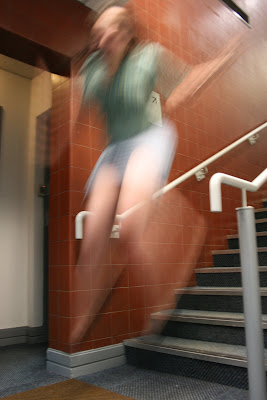We had our DLSR induction today in the Photography department in college. I was kind of expecting to be given a camera, talked through it and then told to spend the rest of the day out in town taking photos, which thankfully wasn't the case. We were first talked through the basic functions of the camera, the benefits and negative aspects of each auto function and when we could use each and the reasons for this, such as how different settings use different set apertures etc. After being talked through these we were given 20 minutes to try and use each different auto setting in and around the college. Mine are below..
Macro.. coffee stirrers in the cafe.
 Landscape.. views from the viscom balcony
Landscape.. views from the viscom balcony
 Normal auto.. horrible flavoured water in the cafe.
Normal auto.. horrible flavoured water in the cafe. Macro.. stunning close up of Rossitron's face.
Macro.. stunning close up of Rossitron's face. Sports.. Tasha and Vic jumping down the stairs.
Sports.. Tasha and Vic jumping down the stairs.

I think this induction was actually very useful, as it has helped my to understand how to use the settings on my own DSLR a little more. Unfortunately we didn't touch very much on the manual settings except for how to set it up for use with the flashes. I definitely want to use the photography studios again, especially to play around with the infinity curve, even though I'm not sure what I could actually use it for at the moment other than messing around.
Also, in line with my comm tech project, this has helped to point out some of the advantages to using a digital camera. The obvious such as how it is possible to delete rubbish photos instead of wasting money on getting them printed (when they don't even give you the photos anyway), and the availability of so many different settings. On my two 35mm film cameras, there are no settings whatsoever, so the photographer has next to no control over what the image comes out like, whereas when using the DSLR the photographer is presented with a wide range of possibilities, numerous settings to help achieve a successful image. As the image is also instantly viewable on the screen, if there are any lighting issues for example, it is possible for the photographer to rectify these before taking another photograph, unlike when using film when it can often be a bit of a gamble for the non-expert.












































